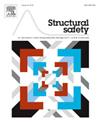Seismic risk and failure modes assessment of steel BRB frames under earthquake sequences
IF 6.3
1区 工程技术
Q1 ENGINEERING, CIVIL
引用次数: 0
Abstract
Buckling-Restrained Braces (BRBs) are characterized by steady and nearly symmetric hysteretic loops, providing large energy dissipation capacity under strong earthquakes. These devices are designed to sustain a specified maximum ductility demand and, if not properly designed, may fail due to excessive inelastic deformations. Moreover, their low post-yielding stiffness may lead the structure to large residual inter-story drifts at the end of the earthquake motion, and the cumulative ductility demand due to repeated plastic excursions may lead to low-cycle fatigue failure of the device core. The risk of reaching either of these failure modes is exacerbated when considering multiple earthquakes. Although BRBs are designed to function as a fuse element, there is a lack of consensus on the criteria for replacement, particularly when large residual deformations are not observed. Recent studies have suggested that BRBs can withstand several loading cycles before developing low-cycle fatigue rupture; thus, the decision to replace a BRB after a single ground motion may be overly conservative. The present study investigates the likelihood of BRBs reaching these failure modes within a stochastic framework that considers the probability of occurrence of multiple earthquakes during the structure’s lifetime. For this purpose, two steel Moment Resisting Frames (MRFs) retrofitted with BRBs are numerically modeled in OpenSees and subjected to the cumulative demand from hazard-consistent multiple earthquake sequences. The demand values are compared with multiple capacity models for low-cycle fatigue in the BRB core, as well as conventional limits for residual drifts and other failure modes. The outcomes of this study suggest that the risk of developing low-cycle fatigue in BRBs is negligible, even when multiple ground motions are considered, while other failure modes are significantly more likely to occur, particularly when the structures are subjected to pulse-like ground motions.
地震序列下BRB钢框架的地震风险及破坏模式评估
屈曲约束支撑结构具有稳定且近似对称的滞回环,在强震作用下具有较大的耗能能力。这些装置的设计是为了维持规定的最大延性需求,如果设计不当,可能会因过度的非弹性变形而失效。此外,它们的低屈服后刚度可能导致结构在地震运动结束时产生较大的残余层间漂移,并且由于反复塑性位移引起的累积延性需求可能导致装置核心的低周疲劳破坏。当考虑多次地震时,达到这些破坏模式中的任何一种的风险都加剧了。虽然brb被设计为保险丝元件,但在更换标准上缺乏共识,特别是在未观察到大残余变形的情况下。最近的研究表明,brb在发生低周疲劳断裂之前可以承受多次加载循环;因此,在一次地面运动后更换BRB的决定可能过于保守。本研究考察了brb在随机框架内达到这些破坏模式的可能性,该框架考虑了结构生命周期内发生多次地震的概率。为此,在OpenSees中对两个经brb改造的钢抗矩框架(mrf)进行了数值模拟,并对危险一致的多重地震序列的累积需求进行了研究。将需求值与BRB岩心低周疲劳的多种容量模型以及传统的残余漂移和其他失效模式的极限进行了比较。本研究的结果表明,即使考虑到多次地震动,brb中发生低周疲劳的风险也可以忽略不计,而其他失效模式更有可能发生,特别是当结构受到脉冲式地震动时。
本文章由计算机程序翻译,如有差异,请以英文原文为准。
求助全文
约1分钟内获得全文
求助全文
来源期刊

Structural Safety
工程技术-工程:土木
CiteScore
11.30
自引率
8.60%
发文量
67
审稿时长
53 days
期刊介绍:
Structural Safety is an international journal devoted to integrated risk assessment for a wide range of constructed facilities such as buildings, bridges, earth structures, offshore facilities, dams, lifelines and nuclear structural systems. Its purpose is to foster communication about risk and reliability among technical disciplines involved in design and construction, and to enhance the use of risk management in the constructed environment
 求助内容:
求助内容: 应助结果提醒方式:
应助结果提醒方式:


